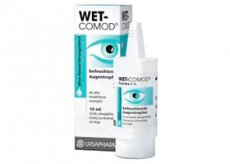Medical expert of the article
New publications
Preparations
Vet commode
Last reviewed: 04.07.2025

All iLive content is medically reviewed or fact checked to ensure as much factual accuracy as possible.
We have strict sourcing guidelines and only link to reputable media sites, academic research institutions and, whenever possible, medically peer reviewed studies. Note that the numbers in parentheses ([1], [2], etc.) are clickable links to these studies.
If you feel that any of our content is inaccurate, out-of-date, or otherwise questionable, please select it and press Ctrl + Enter.

Vet-Komod is a local moisturizing agent for ophthalmological procedures.
The medication is effective in cases of dry eyes caused, among other things, by a lack of mucin. Due to insufficient production of this element by the conjunctiva, the protective film is destroyed, and dry spots appear on the cornea, which can lead to the development of punctate keratitis. The medication effectively copes with the clinical symptoms of dry keratoconjunctivitis (such as burning, dryness, irritation and hyperemia of the conjunctiva).
Pharmacodynamics
The drug works due to the specific activity of the element povidone. The drug has a moisturizing effect and helps synthesize liquid, weakening its evaporation from the corneal surface.
Povidone, which gets onto the conjunctiva and cornea, acts as a replacement for mucin, performing its physiological functions.
The use of the drug not only reduces the intensity of signs of dry cornea, but also prevents the degradation of the epithelial layer of the visual apparatus.
Dosing and administration
Vet-Komod is used in accordance with medical recommendations. In the absence of other prescriptions, it is usually necessary to instill 1 drop of the medicine into each eye. Often, a maximum of 5 injections of the drug per day is sufficient.
To instill the medicine, use the following scheme: first, open the container (hands must be washed), then turn it upside down with the dropper down and press on the bottom of the bottle to ensure correct dosing (this procedure is performed only before the first use). After this, tilt your head back slightly and pull down your lower eyelid with your finger. Then instill the medicine into this area. You need to slowly close your eyes so that the drops are distributed more evenly. After the procedure, close the container, first making sure that the dropper tip is not wet.
One container can only be used by one person.
The medicine is compatible with any type of contact lenses, provided the ophthalmologist’s instructions are followed.
When using drops, care must be taken to ensure that mucous membranes, skin and other surfaces do not touch the tip of the dropper (as this may lead to contamination of the liquid, which will increase the risk of infection).
Use Vet dresser during pregnancy
Vet-Komod does not have systemic therapeutic activity, so it can be prescribed to pregnant and lactating women.
Contraindications
Contraindicated in case of hypersensitivity to the components of the drops.
Caution is required when prescribing after diagnostic or surgical procedures of an ophthalmological nature (the medication may only be used under the supervision of a medical specialist).
Driving a vehicle (car) after using the drug is only possible when visual clarity is restored, because at first, after the instillation procedure, blurred vision may occur.
Side effects Vet dresser
Vet-Komod is usually tolerated without complications, even in cases of prolonged treatment.
Occasionally, signs of intolerance are observed (in which case the drug should be replaced). Symptoms of intolerance include swelling, itching, irritation and burning, as well as inflammation and pain or a feeling of sand inside the eyes. These manifestations are often moderate or mild in intensity and do not require treatment (other than discontinuing the drug).
The use of drops may cause temporary blurred vision.
Interactions with other drugs
The medicine should not be combined with other local ophthalmological agents. If there is a strict need for complex local treatment, it is necessary to fully comply with all doctor's instructions regarding intervals between procedures, as well as the sequence of medication use.
Vet-Komod does not affect the duration and intensity of the effects of systemic drugs.
Shelf life
Vet-Komod can be used for a 3-year period from the date of sale of the medicine. An opened container has a six-month shelf life.
 [ 25 ]
[ 25 ]
Application for children
The use of the drug in pediatrics is prohibited.
 [ 26 ]
[ 26 ]
Analogues
The analogs of the drug are the substances Systane, Optive, Hilo-Comod, Optix Forte with Artelac, Retinol acetate, Defislez and Oxial with Mirtilene Forte, and in addition to this, Hilo-Care and Systane Ultra.
Attention!
To simplify the perception of information, this instruction for use of the drug "Vet commode" translated and presented in a special form on the basis of the official instructions for medical use of the drug. Before use read the annotation that came directly to medicines.
Description provided for informational purposes and is not a guide to self-healing. The need for this drug, the purpose of the treatment regimen, methods and dose of the drug is determined solely by the attending physician. Self-medication is dangerous for your health.

